Searching the Help
To search for information in the Help, type a word or phrase in the Search box. When you enter a group of words, OR is inferred. You can use Boolean operators to refine your search.
Results returned are case insensitive. However, results ranking takes case into account and assigns higher scores to case matches. Therefore, a search for "cats" followed by a search for "Cats" would return the same number of Help topics, but the order in which the topics are listed would be different.
| Search for | Example | Results |
|---|---|---|
| A single word | cat
|
Topics that contain the word "cat". You will also find its grammatical variations, such as "cats". |
|
A phrase. You can specify that the search results contain a specific phrase. |
"cat food" (quotation marks) |
Topics that contain the literal phrase "cat food" and all its grammatical variations. Without the quotation marks, the query is equivalent to specifying an OR operator, which finds topics with one of the individual words instead of the phrase. |
| Search for | Operator | Example |
|---|---|---|
|
Two or more words in the same topic |
|
|
| Either word in a topic |
|
|
| Topics that do not contain a specific word or phrase |
|
|
| Topics that contain one string and do not contain another | ^ (caret) |
cat ^ mouse
|
| A combination of search types | ( ) parentheses |
|
Mappings Used in the Topology Integration
OpsCx for Microsoft SCOM comes with preconfigured topology mappings that you can customize. The topology mappings are not defined in the Operations Connector policy for Microsoft SCOM topology, but rather in the topology synchronization package of OpsCx for Microsoft SCOM. This package is installed on the Microsoft SCOM host, and is registered with the integrated Microsoft SCOM instance.
The following sections list default mappings available in the topology synchronization package of OpsCx for Microsoft SCOM for different Microsoft SCOM management packs:
Windows Core Library Management Pack
The topology synchronization package maps the following classes of Microsoft SCOM objects from the Windows Core Library management pack to the RTSM database of OMi.
Windows Computer
Microsoft SCOM objects of this class are mapped to CIs of the Windows type.
The following table shows the mapping between the Microsoft SCOM object attributes and the CI attributes:
| CI Attribute Name | CI Attribute Value |
|---|---|
Domain Name
|
Microsoft SCOM object attribute: DNS Domain Name |
Host Key
|
Microsoft SCOM object ID |
Discovered OS Name
|
Display Name attribute from the child Microsoft SCOM object of the Windows Operating System class |
Discovered OS Version
|
Operating System Version attribute from the child Microsoft SCOM object of the Windows Operating System class |
Discovered OS Vendor
|
Microsoft
|
Host OS Release
|
Build Number attribute from the child Microsoft SCOM object of the Windows Operating System class |
NT Service Pack
|
Service Pack Version attribute from the child Microsoft SCOM object of the Windows Operating System class |
NT Physical Memory
|
Physical Memory (KB) attribute from the child Microsoft SCOM object of the Windows Operating System class |
Memory Size
|
Physical Memory (KB) attribute from the child Microsoft SCOM object of the Windows Operating System class |
NT Processors Number
|
Logical processors attribute from the child Microsoft SCOM object of the Windows Operating System class |
NT Main Processor Speed
|
Speed attribute from the child Microsoft SCOM object of the <WindowsOperatingSystem> Processor class |
NT Main Processor Type
|
Based on the |
Name
|
Microsoft SCOM object attribute NetBIOS Computer Name if available, otherwise Display Name |
Net Bios Name
|
Microsoft SCOM object attribute NetBIOS Computer Name if available, otherwise Display Name |
Primary DNS Name
|
Microsoft SCOM object attribute DNS Name if available, otherwise Display Name |
No relations are mapped for Microsoft SCOM objects of this class.
Windows Server Operating System Management Pack
The topology synchronization package maps all Windows operating system objects deriving their class from the Windows Core Library Management Pack.
The following diagram presents an overview of the CIs and relations that the topology synchronization package maps in the RTSM database of OMi for the Windows Server Operating System management pack.
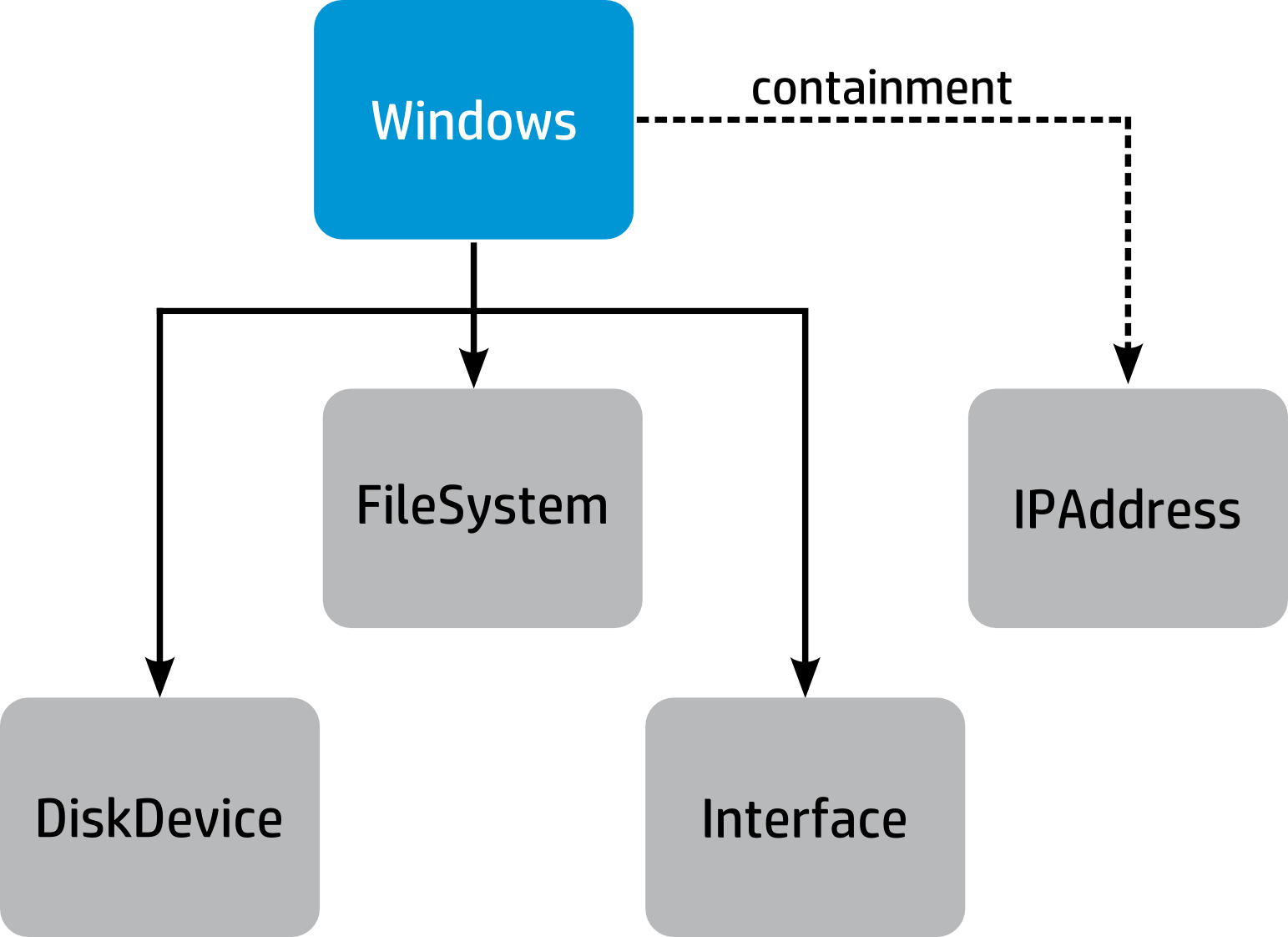
The topology synchronization package maps the following classes of Microsoft SCOM objects from the Windows Server Operating System management pack to the RTSM database of OMi.
LogicalDisk
Microsoft SCOM objects of this class are mapped to CIs of the FileSystem type.
The following table shows the mapping between the Microsoft SCOM object attributes and the CI attributes:
| CI Attribute Name | CI Attribute Value |
|---|---|
Mount Point
|
Microsoft SCOM object attribute Device ID with colons (:) removed |
Name
|
Microsoft SCOM object attribute Device Name with colons (:) removed |
Disk Size
|
Microsoft SCOM object attribute: Size (Bytes) |
Disk Type
|
Microsoft SCOM object attribute: Device Description |
Filesystem Type
|
Microsoft SCOM object attribute: FileSystem |
CIs that represent Microsoft SCOM objects of this class have a parent relation from a Windows CI.
PhysicalDisk
Microsoft SCOM objects of this class are mapped to CIs of the DiskDevice type.
The following table shows the mapping between the Microsoft SCOM object attributes and the CI attributes:
| CI Attribute Name | CI Attribute Value |
|---|---|
Name
|
Microsoft SCOM object attribute: Display Name |
Model Name
|
Microsoft SCOM object attribute: Caption |
Vendor
|
Microsoft SCOM object attribute: Manufacturer |
Description
|
Microsoft SCOM object attribute: Device Description |
CIs that represent Microsoft SCOM objects of this class have a parent relation from a Windows CI.
NetworkAdapter
Microsoft SCOM objects of this class are mapped to CIs of the Interface type.
The following table shows the mapping between the Microsoft SCOM object attributes and the CI attributes:
| CI Attribute Name | CI Attribute Value |
|---|---|
Name |
Microsoft SCOM object attribute: Device Name |
MAC Address |
Microsoft SCOM object attribute MAC Address with hyphens (-) removed |
Interface Description |
Microsoft SCOM object attribute: Device Description |
Interface Index |
Microsoft SCOM object attribute: Index |
Interface Name |
Microsoft SCOM object attribute: Display Name |
For this type of Microsoft SCOM objects, the topology synchronization package also creates CIs of the IpAddress type. These CIs become children of the CI that is related to the Microsoft SCOM object of the NetworkAdapter class. The following table shows the mappings between Microsoft SCOM object attributes and attributes of the children CIs:
| CI Attribute Name | CI Attribute Value |
|---|---|
Name |
One IP address from the IP Address(es) Microsoft SCOM object attribute |
Routing Domain
|
DefaultDomain
|
IP Address
|
One IP address from the IP Address(es) Microsoft SCOM object attribute |
IP Address Value
|
One IP address from the IP Address(es) Microsoft SCOMobject attribute |
User Label
|
One IP address from the IP Address(es) Microsoft SCOM object attribute |
IP Netmask |
Microsoft SCOM object attribute: IP Subnet |
IP Netclass |
Either A, B, or C |
IP Netaddr |
Network address calculated from the subnet and IP address |
IP Address Type
|
Either IPv4 or IPv6, depending on the IP address |
CIs that represent Microsoft SCOM objects of the NetworkAdapter class have a parent relation from a Windows CI.
CIs that represent Microsoft SCOM objects of the IPAddress class have a containment relation from a Windows CI.
Windows Cluster Library Management Pack
The following diagram presents an overview of the CIs and relations that the topology synchronization package maps in the RTSM database of OMi for the Windows Cluster Library management pack.

The topology synchronization package maps the following classes of Microsoft SCOM objects from the Windows Cluster Library management pack to the Run-Time Service Model database in OMi.
Windows Cluster
Microsoft SCOM objects of this class are mapped to CIs of the MS Cluster type.
The following table shows the mapping between the Microsoft SCOM object attributes and the CI attributes:
| CI Attribute Name | CI Attribute Value |
|---|---|
Name
|
Microsoft SCOM object attribute: Display Name |
Vendor
|
Microsoft SCOM object attribute: Vendor ID |
Version
|
Microsoft SCOM object attribute: Highest Version |
CIs that represent Microsoft SCOM objects of this class have a membership relation to a Cluster Software CI.
Windows Cluster Service
SCOM objects of this class are mapped to CIs of the Cluster Software type.
The following table shows the mapping between the Microsoft SCOM object attributes and the CI attributes:
| CI Attribute Name | CI Attribute Value |
|---|---|
Name
|
Fully qualified domain name (FQDN) of the parentWindows Computer object |
Discovered Product Name
|
Microsoft Cluster Service
|
Application Category
|
Cluster
|
Vendor
|
Microsoft Corp.
|
CIs that represent Microsoft SCOM objects of this class have the following relations:
-
parent relation from a
WindowsCI -
execution environment relation to a
Cluster Resource GroupCI -
ownership relation to a
Cluster Resource GroupCI
Windows Computer (Child of Windows Cluster Resource Group)
Microsoft SCOM objects of the Windows Computer class that are children of a Windows Cluster Resource Group object are mapped to CIs of the Cluster Resource Group type.
The following table shows the mapping between the Microsoft SCOM object attributes and the CI attributes:
| CI Attribute Name | CI Attribute Value |
|---|---|
Domain Name
|
Microsoft SCOM object attribute: DNS Domain Name |
Host Key
|
Microsoft SCOM object ID |
Name
|
Microsoft SCOM object attribute: NetBIOS Computer Name |
Net Bios Name
|
Microsoft SCOM object attribute: NetBIOS Computer Name |
Primary DNS Name
|
Microsoft SCOM object attribute: DNS Name |
User label
|
Parent Windows Cluster Resource Group Microsoft SCOM object attribute: Original Group Name |
Discovered OS Name
|
Display Name attribute from the child Microsoft SCOM object of the Windows Operating System class |
Discovered OS Vendor
|
Microsoft Corp.
|
Discovered OS Version
|
Operating System Version attribute from the child Microsoft SCOM object of the Windows Operating System class |
Host OS Release
|
Build Number attribute from the child Microsoft SCOM object of the Windows Operating System class |
CIs that represent Microsoft SCOM objects of this class have the following relations:
-
containment relation from an
MS ClusterCI -
containment relation to a
NetworkAdapterCI
Windows Server Hyper-V Management Pack
The following diagram presents an overview of the CIs and relations that the topology synchronization package maps in the RTSM database of OMi for the Windows Server Hyper-V management pack (its Library part: Microsoft.Windows.HyperV.Library).
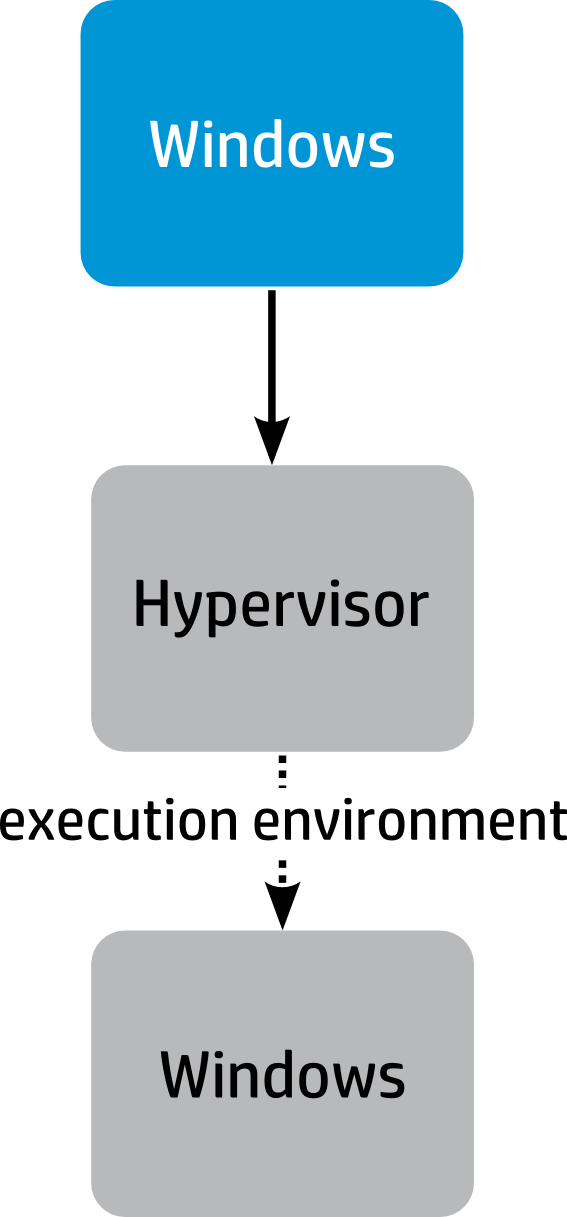
The topology synchronization package maps the following classes of Microsoft SCOM objects from the Windows Server Hyper-V management pack to the RTSM database of OMi.
Server Running Hyper-V
Microsoft SCOM objects of this class are mapped to CIs of the Hypervisor type.
The following table shows the mapping between the Microsoft SCOM object attributes and the CI attributes:
| CI Attribute Name | CI Attribute Value |
|---|---|
Name
|
Microsoft SCOM object attribute: Server Name |
Discovered Product Name
|
Hyper-V hypervisor
|
Vendor
|
Microsoft Corp.
|
CIs that represent Microsoft SCOM objects of this class have a parent relation from a Windows CI.
Windows Computer (Child of Hyper-V Virtual Machine)
Microsoft SCOM objects of the Windows Computer class that are children of a Hyper-V Virtual Machine Microsoft SCOM object are mapped to CIs of the Windows type.
The following table shows the mapping between the Microsoft SCOM object attributes and the CI attributes:
| CI Attribute Name | CI Attribute Value |
|---|---|
Domain Name
|
Microsoft SCOM object attribute: DNS Domain Name |
Host Key
|
Microsoft SCOM object ID |
Discovered OS Name
|
Display Name attribute from the child Microsoft SCOM object of the Windows Operating System class |
Discovered OS Version
|
Operating System Version attribute from the child Microsoft SCOM object of the Windows Operating System class |
Discovered OS Vendor
|
Microsoft
|
Host OS Release
|
Build Number attribute from the child Microsoft SCOM object of the Windows Operating System class |
NT Service Pack
|
Service Pack Version attribute from the child Microsoft SCOM object of the Windows Operating System class |
NT Physical Memory
|
Physical Memory (KB) attribute from the child Microsoft SCOM object of the Windows Operating System class |
Memory Size
|
Physical Memory (KB) attribute from the child Microsoft SCOM object of the Windows Operating System class |
NT Processors Number
|
Logical processors attribute from the child Microsoft SCOM object of the Windows Operating System class |
NT Main Processor Speed
|
Speed attribute from the Microsoft SCOM child object of the <WindowsOperatingSystem> Processor class |
NT Main Processor Type
|
Based on the |
Name
|
NetBIOS Computer Name Microsoft SCOM object attribute if available, otherwise Display Name |
Net Bios Name
|
NetBIOS Computer Name Microsoft SCOM object attribute if available, otherwise Display Name |
Primary DNS Name
|
DNS Name Microsoft SCOM object attribute if available, otherwise Display Name |
Discovered Model
|
Virtual Machine
|
Host Is Virtual
|
True
|
Serial Number
|
Parent Hyper-V Virtual Machine Microsoft SCOM object attribute Virtual Machine Id |
User Label
|
Parent Hyper-V Virtual Machine Microsoft SCOM object attribute Display Name |
CIs that represent Microsoft SCOM objects of this class have the execution environment relation with a Hypervisor CI.
Windows DNS Server Management Pack
The following diagram presents an overview of the CIs and relations that the topology synchronization package maps in the RTSM database of OMi for the Windows DNS Server management pack (its Library part: Microsoft.Windows.DNS.Server.Library).
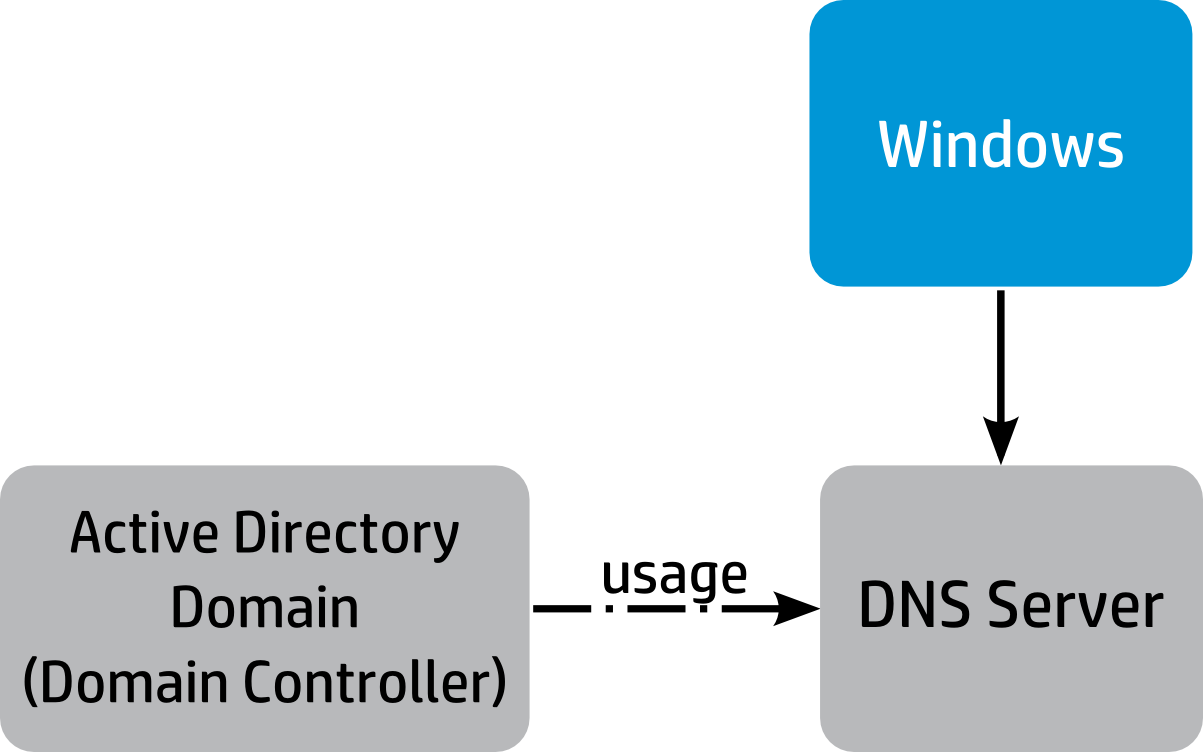
The topology synchronization package maps the following classes of Microsoft SCOM objects from the Windows DNS Server management pack to the RTSM database of OMi.
DNS Server
Microsoft SCOM objects of this class are mapped to CIs of the Dns Server type.
The following table shows the mapping between the Microsoft SCOM object attributes and the CI attributes:
| CI Attribute Name | CI Attribute Value |
|---|---|
Discovered Product Name
|
DNS Server
|
Application IP
|
Microsoft SCOM object attribute: Listening IPs |
Name
|
Microsoft SCOM object attribute: Display Name |
CIs that represent Microsoft SCOM objects of this class have the following relations:
-
parent relation from a
WindowsCI -
usage relation from the corresponding
Active Directory DomainCI that represents a domain controller
Active Directory Domain Services Management Pack
The following diagram presents an overview of the CIs and relations that the topology synchronization package maps in the RTSM database of OMi for the Active Directory Domain Services management pack.
For the releases 2008 and 2003 of Active Directory Domain Services, one of the following Discovery parts of the management pack is used: Microsoft.Windows.Server.AD.2008.Discovery or Microsoft.Windows.Server.AD.2003.Discovery.
For other Active Directory Domain Services releases, objects deriving from the Microsoft.Windows.Server.AD.Library part are mapped.
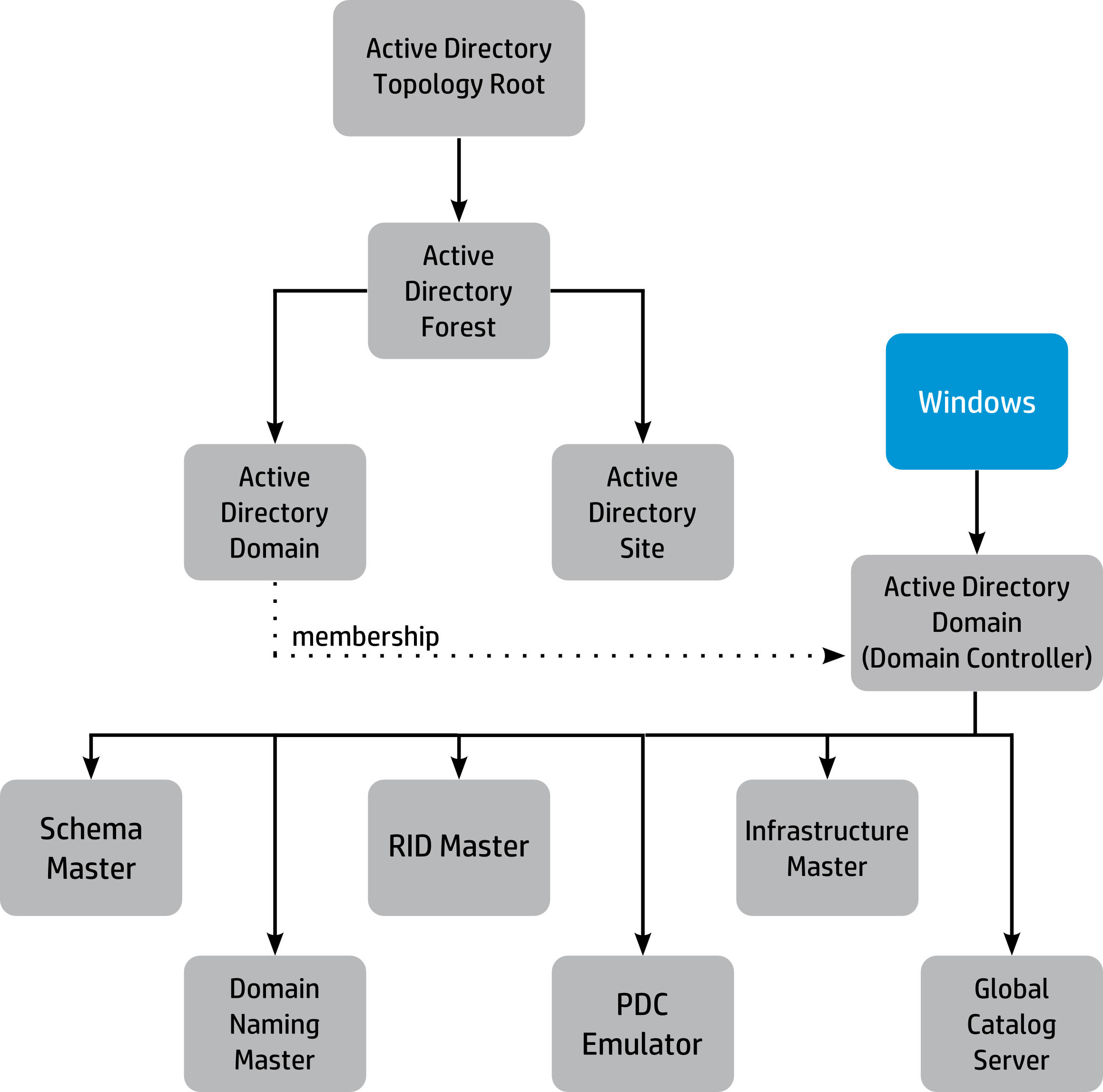
The topology synchronization package maps the following classes of Microsoft SCOM objects from the Active Directory Domain Services management pack to the RTSM database of OMi.
Active Directory Topology Root
Microsoft SCOM objects of this class are mapped to CIs of the Active Directory Topology Root type.
The Microsoft SCOM object's Display Name attribute is mapped to the CI's Name attribute.
No relations are mapped for Microsoft SCOM objects of this class.
Active Directory Forest
Microsoft SCOM objects of this class are mapped to CIs of the Active Directory Forest type.
The Microsoft SCOM object's Display Name attribute is mapped to the CI's Name attribute.
The CI of type Active Directory Forest is mapped to a parent CI of the Active Directory Topology Root type.
Active Directory Site
Microsoft SCOM objects of this class are mapped to CIs of the Active Directory Site type.
The Microsoft SCOM object's Display Name attribute is mapped to the CI's Name attribute.
The CI of type Active Directory Site is mapped to a parent CI of the Active Directory Forest type.
Active Directory Domain
Microsoft SCOM objects of this class are mapped to CIs of the Active Directory Domain type.
The Microsoft SCOM object's Display Name attribute is mapped to the CI's Name attribute.
The CI of type Active Directory Domain is mapped to a parent CI of the Active Directory Forest type.
Active Directory Domain Controller Server 2008 Computer Role, Active Directory Domain Controller Server 2003 Computer Role
Microsoft SCOM objects of these classes are mapped to CIs of the Active Directory Domain type.
The following table shows the mapping between the Microsoft SCOM object attributes and the CI attributes:
| CI Attribute Name | CI Attribute Value |
|---|---|
Discovered Product Name
|
AD Domain Controller |
Name
|
Microsoft SCOM object attribute: Display Name |
DNS Server
|
Parent Microsoft SCOM object attribute DNS Name |
Domain Name
|
Parent Microsoft SCOM object attribute Domain DNS Name |
Site Name
|
Parent Microsoft SCOM object attribute Active Directory Site |
For this type of the Microsoft SCOM object, the topology synchronization package maps some attributes as CIs. The CIs become children of the CI that is related to the Microsoft SCOM object. The following table shows the mappings between Microsoft SCOM object attributes and children CIs:
| SCOM Object Attribute | Child CI Type |
|---|---|
Schema Master
|
SchemaMaster
|
Domain Naming Master
|
DomainNamingMaster
|
RID Master
|
RelativeIDMaster
|
PDC Emulator
|
PrimaryDomainControllerMaster
|
Infrastructure Master
|
InfrastructureMaster
|
Global Catalog Server
|
GlobalCatalogServer
|
CIs that represent Microsoft SCOM objects of this class have the following relations:
-
parent relation to a
WindowsCI -
membership relations from the
Active Directory DomainandActive Directory SiteCIs
Active Directory Lightweight Directory Services Management Pack
The following diagram presents an overview of the CIs and relations that the topology synchronization package maps in the RTSM database of OMi for the Active Directory Lightweight Directory Services management pack (its Library part: Microsoft.Windows.Server.LDS.Library).
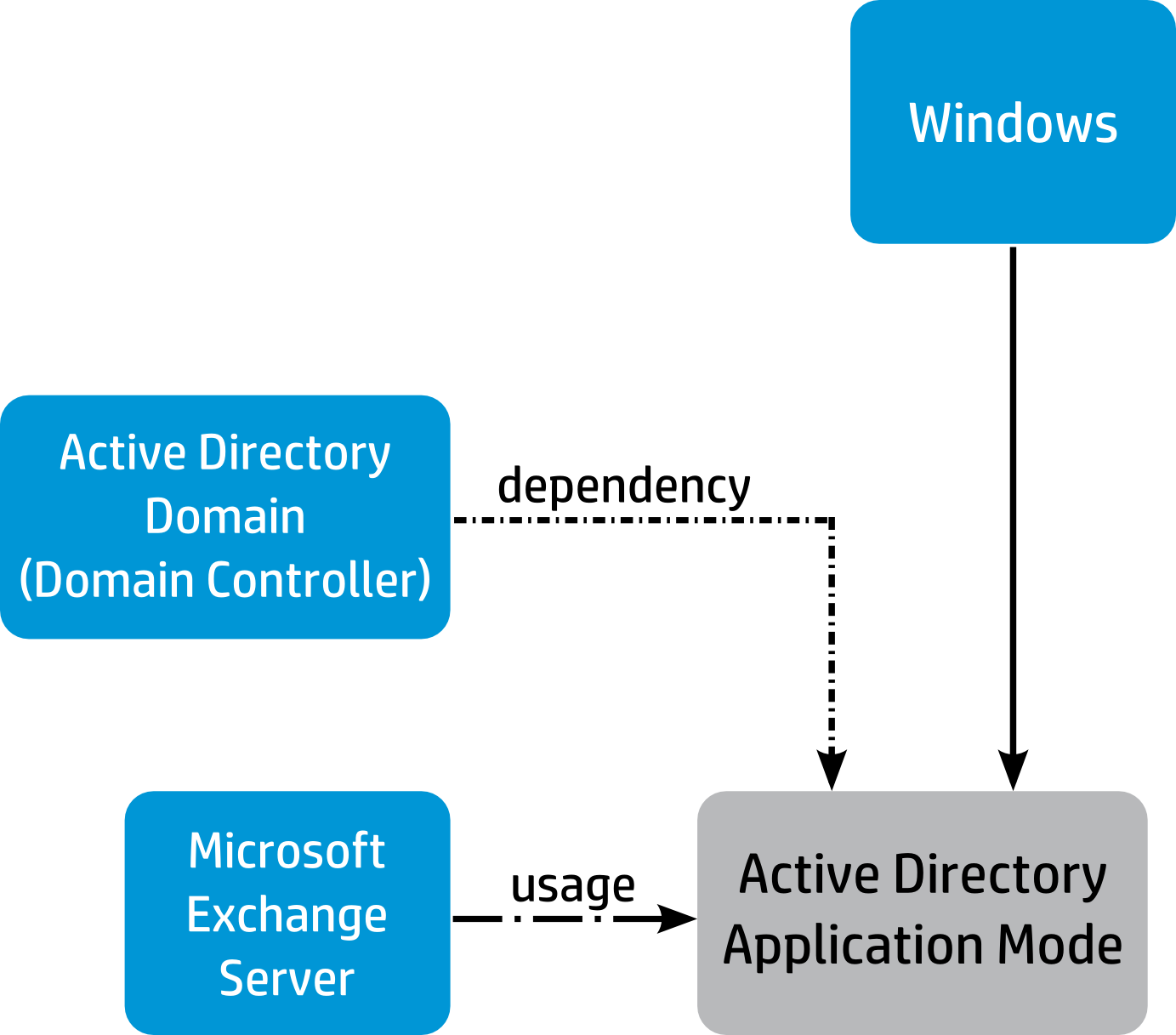
The topology synchronization package maps the following classes of Microsoft SCOM objects from the Active Directory Lightweight Directory Services management pack to the RTSM database of OMi.
Services Instance
Microsoft SCOM objects of this class are mapped to CIs of the Active Directory Application Mode type.
The following table shows the mapping between the Microsoft SCOM object attributes and the CI attributes:
| CI Attribute Name | CI Attribute Value |
|---|---|
Name
|
Microsoft SCOM object attribute: Display Name |
Discovered Product Name
|
ADAM
|
ADAM Instance Name
|
Microsoft SCOM object attribute: Display Name |
Exchange Server Name
|
Display Name attribute from the sibling Microsoft SCOM object of the Microsoft Exchange 2010 Server orExchange 2007 Common Components class |
Vendor
|
Microsoft
|
Application Category
|
Enterprise App
|
CIs that represent Microsoft SCOM objects of this class have the following relations:
-
parent relation from a
WindowsCI -
usage relation from a
Microsoft Exchange ServerCI -
usage relation to an
Active Directory DomainCI that represents a domain controller
Exchange Server 2010 Management Pack
The following diagram presents an overview of the CIs and relations that the topology synchronization package maps in the RTSM database of OMi for the Exchange Server 2010 management pack.

The topology synchronization package maps the following classes of Microsoft SCOM objects from the Exchange Server 2010 management pack to the RTSM database of OMi.
Organization
Microsoft SCOM objects of this class are mapped to CIs of the Exchange Organization type.
The Microsoft SCOM object's Organization Name attribute is mapped to the CI's Name attribute.
CIs that represent Microsoft SCOM objects of this class have a membership relation from an Active Directory Forest CI.
Microsoft Exchange 2010 Server
Microsoft SCOM objects of this class are mapped to CIs of the MicrosoftExchangeServer type.
The following table shows the mapping between the Microsoft SCOM object attributes and the CI attributes:
| CI Attribute Name | CI Attribute Value |
|---|---|
Discovered Product Name
|
Microsoft Exchange Server 2010
|
Exchange Server Name
|
Microsoft SCOM object attribute: Display Name |
FQDN
|
Microsoft SCOM object attribute: DNS Name |
Application Category
|
Mail
|
Name
|
Microsoft SCOM object attribute: Display Name |
Vendor
|
Microsoft Corp.
|
Version
|
2010
|
CIs that represent Microsoft SCOM objects of this class have the following relations:
-
parent relation from a
WindowsCI -
membership relation from an
Exchange OrganizationCI -
membership relation from an
Active Directory SiteCI -
usage relation to an
Active Directory DomainCI that represents a domain controller
Client Access
Microsoft SCOM objects of this class are mapped to CIs of the Exchange Client Access Server type.
The Microsoft SCOM object's Display Name attribute is mapped to the CI's Name attribute.
CIs that represent Microsoft SCOM objects of this class have a parent relation from a Microsoft Exchange Server CI.
Edge Transport
Microsoft SCOM objects of this class are mapped to CIs of the Exchange Edge Server type.
The Microsoft SCOM object's Display Name attribute is mapped to the CI's Name attribute.
CIs that represent Microsoft SCOM objects of this class have a parent relation from a Microsoft Exchange Server CI.
Hub Transport
Microsoft SCOM objects of this class are mapped to CIs of the Exchange Hub Server type.
The Microsoft SCOM object's Display Name attribute is mapped to the CI's Name attribute.
CIs that represent Microsoft SCOM objects of this class have a parent relation from a Microsoft Exchange Server CI.
Mailbox
Microsoft SCOM objects of this class are mapped to CIs of the Exchange Mail Server type.
The Microsoft SCOM object's Display Name attribute is mapped to the CI's Name attribute.
CIs that represent Microsoft SCOM objects of this class have a parent relation from a Microsoft Exchange Server CI.
Unified Messaging
Microsoft SCOM objects of this class are mapped to CIs of the Exchange Unified Messaging Server type.
The Microsoft SCOM object's Display Name attribute is mapped to the CI's Name attribute.
CIs that represent Microsoft SCOM objects of this class have a parent relation from a Microsoft Exchange Server CI.
Mailbox Database Mounted
Microsoft SCOM objects of this class are mapped to CIs of the Exchange Mailbox Database type.
The following table shows the mapping between the Microsoft SCOM object attributes and the CI attributes:
| CI Attribute Name | CI Attribute Value |
|---|---|
Name
|
Microsoft SCOM object attribute: Database Name |
Data GUID
|
Microsoft SCOM object ID |
Database Path
|
Microsoft SCOM object attribute: EDB File Path |
Transaction Log Path
|
Microsoft SCOM object attribute: Log Folder Path |
CIs that represent Microsoft SCOM objects of this class have the following relations:
-
parent relation from a
Microsoft Exchange ServerCI -
usage relation to a
LogicalDiskCI
Mailbox Database Availability Group
Microsoft SCOM objects of this class are mapped to CIs of the Exchange Database Availability Group type.
The Microsoft SCOM object's Instance Name attribute is mapped to the CI's Name attribute.
CIs that represent Microsoft SCOM objects of this class have the following relations:
-
parent relation from a
Microsoft Exchange ServerCI -
membership relation from a
Microsoft Exchange ServerCI
Exchange Server 2007 Management Pack
The following diagram presents an overview of the CIs and relations that the topology synchronization package maps in the RTSM database of OMi for the Exchange Server 2007 management pack (its Library part: Microsoft.Exchange.Server.2007.Library).
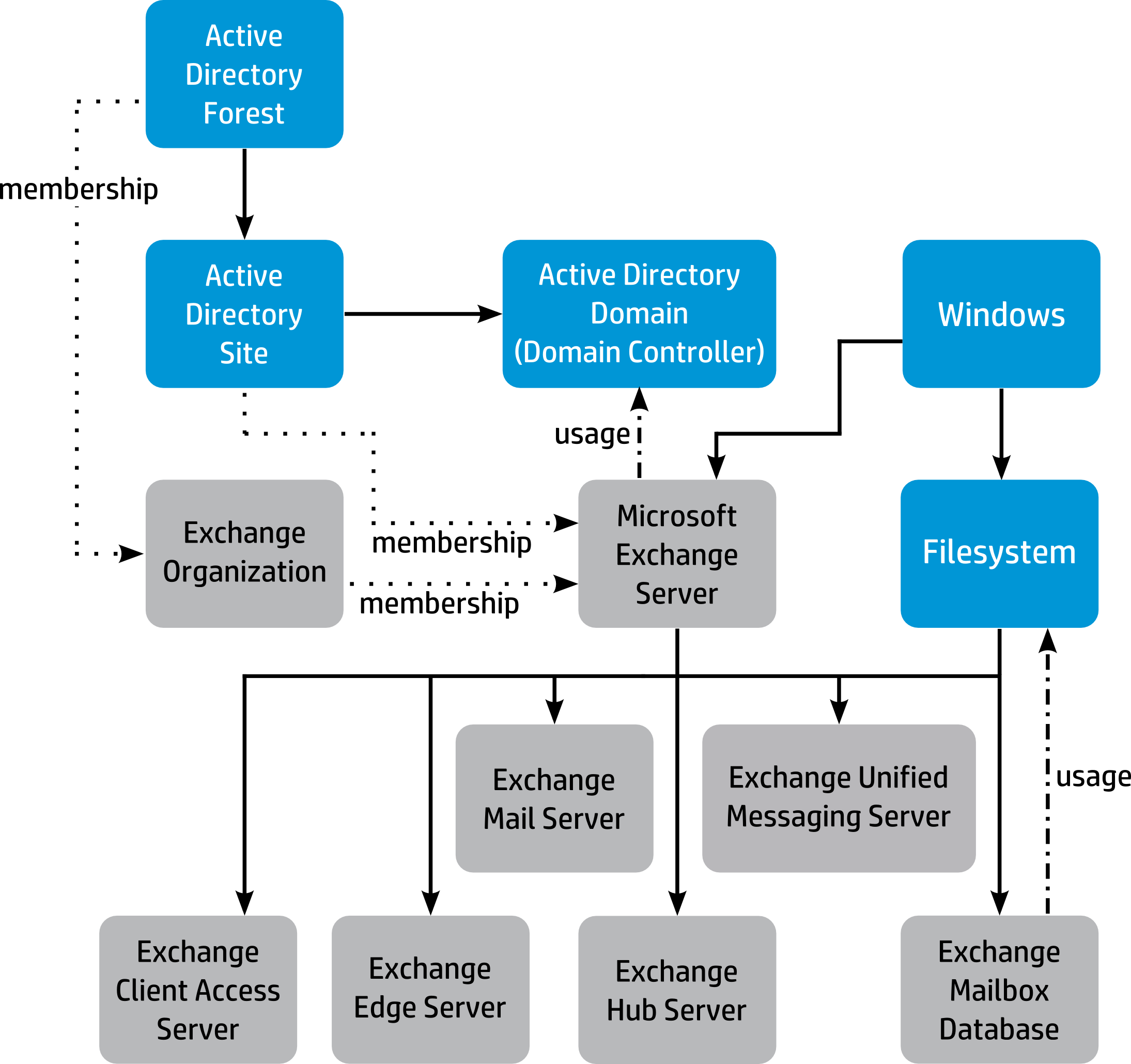
The topology synchronization package maps the following classes of Microsoft SCOM objects from the Exchange Server 2007 management pack to the RTSM database of OMi.
Exchange 2007 Organization
Microsoft SCOM objects of this class are mapped to CIs of the Exchange Organization type.
The Microsoft SCOM object's Organization Name attribute is mapped to the CI's Name attribute.
CIs that represent Microsoft SCOM objects of this class have a membership relation from an Active Directory Forest CI.
Exchange 2007 Common Components
Microsoft SCOM objects of this class are mapped to CIs of the MicrosoftExchangeServer type.
The following table shows the mapping between the Microsoft SCOM object attributes and the CI attributes:
| CI Attribute Name | CI Attribute Value |
|---|---|
Name
|
Microsoft SCOM object attribute: Display Name |
Discovered Product Name
|
Microsoft Exchange Server 2007
|
Exchange Server Name
|
Microsoft SCOM object attribute: Display Name |
FQDN
|
Fully qualified domain name (FQDN) of the parent Windows Computer object |
Application Category
|
Mail
|
Vendor
|
Microsoft
|
Version
|
2007
|
CIs that represent Microsoft SCOM objects of this class have the following relations:
-
parent relation from a
WindowsCI -
membership relation from an
Exchange OrganizationCI -
membership relation from an
Active Directory SiteCI -
usage relation to an
Active Directory DomainCI that represents a domain controller
Exchange 2007 Client Access Role
Microsoft SCOM objects of this class are mapped to CIs of the Exchange Client Access Server type.
The Microsoft SCOM object's Display Name attribute is mapped to the CI's Name attribute.
CIs that represent Microsoft SCOM objects of this class have a parent relation from a Microsoft Exchange Server CI.
Exchange 2007 Standalone Mailbox Role
Microsoft SCOM objects of this class are mapped to CIs of the Exchange Mail Server type.
The Microsoft SCOM object's Display Name attribute is mapped to the CI's Name attribute.
CIs that represent Microsoft SCOM objects of this class have a parent relation from a Microsoft Exchange Server CI.
Exchange 2007 Edge Transport Role
Microsoft SCOM objects of this class are mapped to CIs of the Exchange Edge Server type.
The Microsoft SCOM object's Display Name attribute is mapped to the CI's Name attribute.
CIs that represent Microsoft SCOM objects of this class have a parent relation from a Microsoft Exchange Server CI.
Exchange 2007 Hub Transport Role
Microsoft SCOM objects of this class are mapped to CIs of the Exchange Hub Server type.
The Microsoft SCOM object's Display Name attribute is mapped to the CI's Name attribute.
CIs that represent Microsoft SCOM objects of this class have a parent relation from a Microsoft Exchange Server CI.
Exchange 2007 Unified Messaging Role
Microsoft SCOM objects of this class are mapped to CIs of the Exchange Unified Messaging Server type.
The Microsoft SCOM object's Display Name attribute is mapped to the CI's Name attribute.
CIs that represent Microsoft SCOM objects of this class have a parent relation from a Microsoft Exchange Server CI.
Exchange 2007 Mailbox Database
Microsoft SCOM objects of this class are mapped to CIs of the Exchange Mailbox Database type.
The following table shows the mapping between the Microsoft SCOM object attributes and the CI attributes:
| CI Attribute Name | CI Attribute Value |
|---|---|
Name
|
Microsoft SCOM object attribute: Display Name |
Data GUID
|
Microsoft SCOM object ID |
Database Path
|
Microsoft SCOM object attribute: Database Edb File Path |
Transaction Log Path
|
Microsoft SCOM object attribute: Database Log File Path |
CIs that represent Microsoft SCOM objects of this class have the following relations:
-
parent relation from a
Microsoft Exchange ServerCI -
usage relation to a
LogicalDiskCI
SQL Server Management Packs
The following diagram presents an overview of the CIs and relations that the topology synchronization package maps in the RTSM database of OMi for the SQL Server management packs (their Library part: Microsoft.SQLServer.Library).
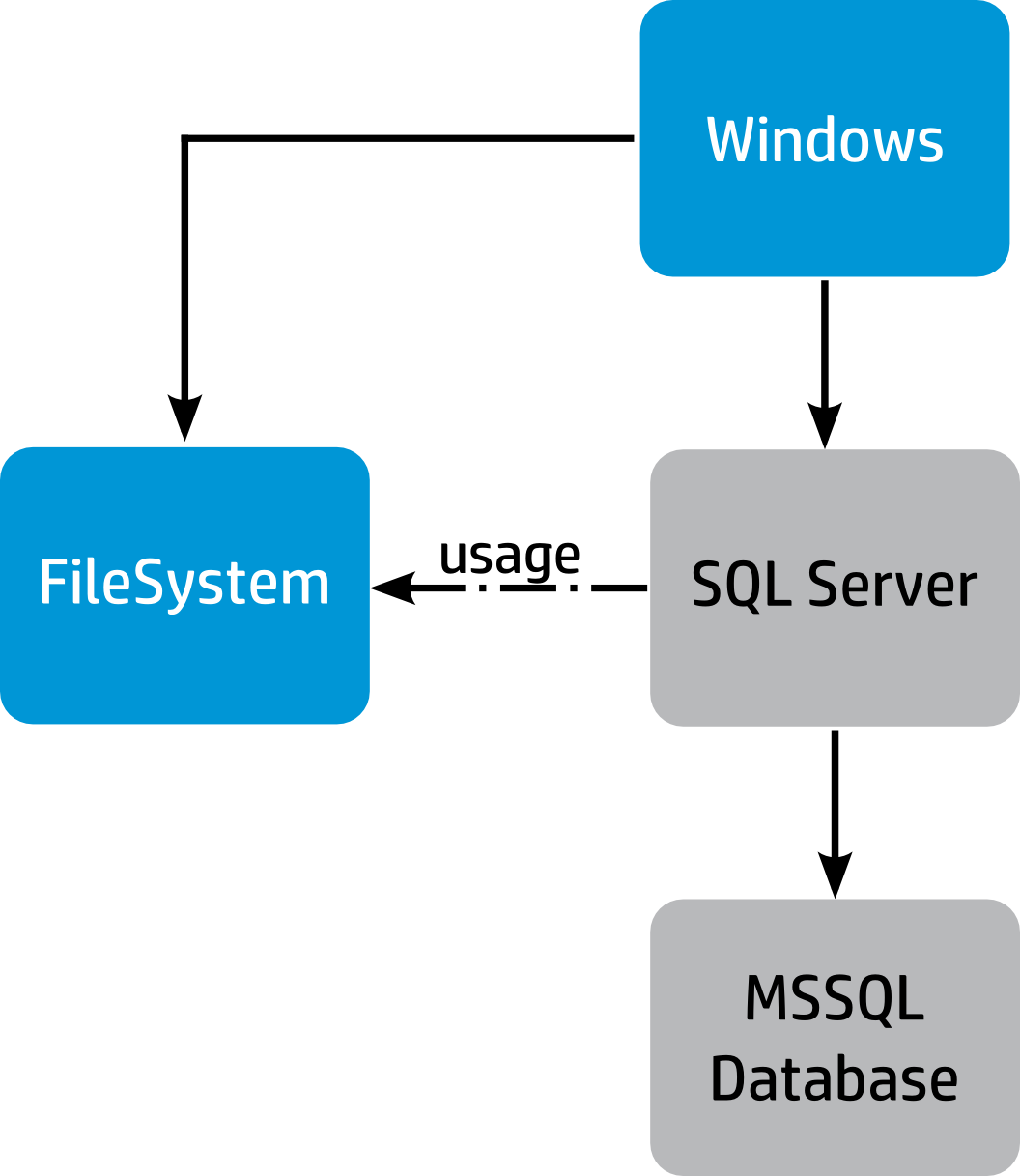
The topology synchronization package maps the following classes of Microsoft SCOM objects from the SQL Server management pack to the RTSM database of OMi.
SQL DB Engine
Microsoft SCOM objects of this class are mapped to CIs of the SQL Server type.
The following table shows the mapping between the Microsoft SCOM object attributes and the CI attributes:
| CI Attribute Name | CI Attribute Value |
|---|---|
Discovered Product Name
|
Microsoft SCOM object attribute: SQL Server |
Version
|
Microsoft SCOM object attribute: Version |
Database DB Connection String
|
Microsoft SCOM object attribute: Connection String |
Database DB Install Path
|
Microsoft SCOM object attribute:Master Database Location |
Application Path
|
Microsoft SCOM object attribute: Install Path |
Language
|
Microsoft SCOM object attribute: Language |
Name
|
Microsoft SCOM object attribute: Instance Name |
Application User Name
|
Microsoft SCOM object attribute: Account Name |
Application Category
|
Database
|
Database DB Type
|
sqlserver
|
Vendor
|
Microsoft Corp.
|
Application IP
|
IP address returned by nslookup for the hostname within the Connection String Microsoft SCOM object attribute |
CIs that represent Microsoft SCOM objects of this class have the following relations:
-
parent relation from a
WindowsCI -
usage relation to a
LogicalDiskCI
SQL Database
Microsoft SCOM objects of this class are mapped to CIs of the MSSQL Database type.
The following table shows the mapping between the Microsoft SCOM object attributes and the CI attributes:
| CI Attribute Name | CI Attribute Value |
|---|---|
User Label
|
Microsoft SCOM object attribute: Display Name |
Name
|
Microsoft SCOM object attribute: Database Name |
CIs that represent Microsoft SCOM objects of this class have a parent relation from an SQL Server CI.
Internet Information Services Management Packs
The following diagram presents an overview of the CIs and relations that the topology synchronization package maps in the RTSM database of OMi for the Internet Information Services management packs.
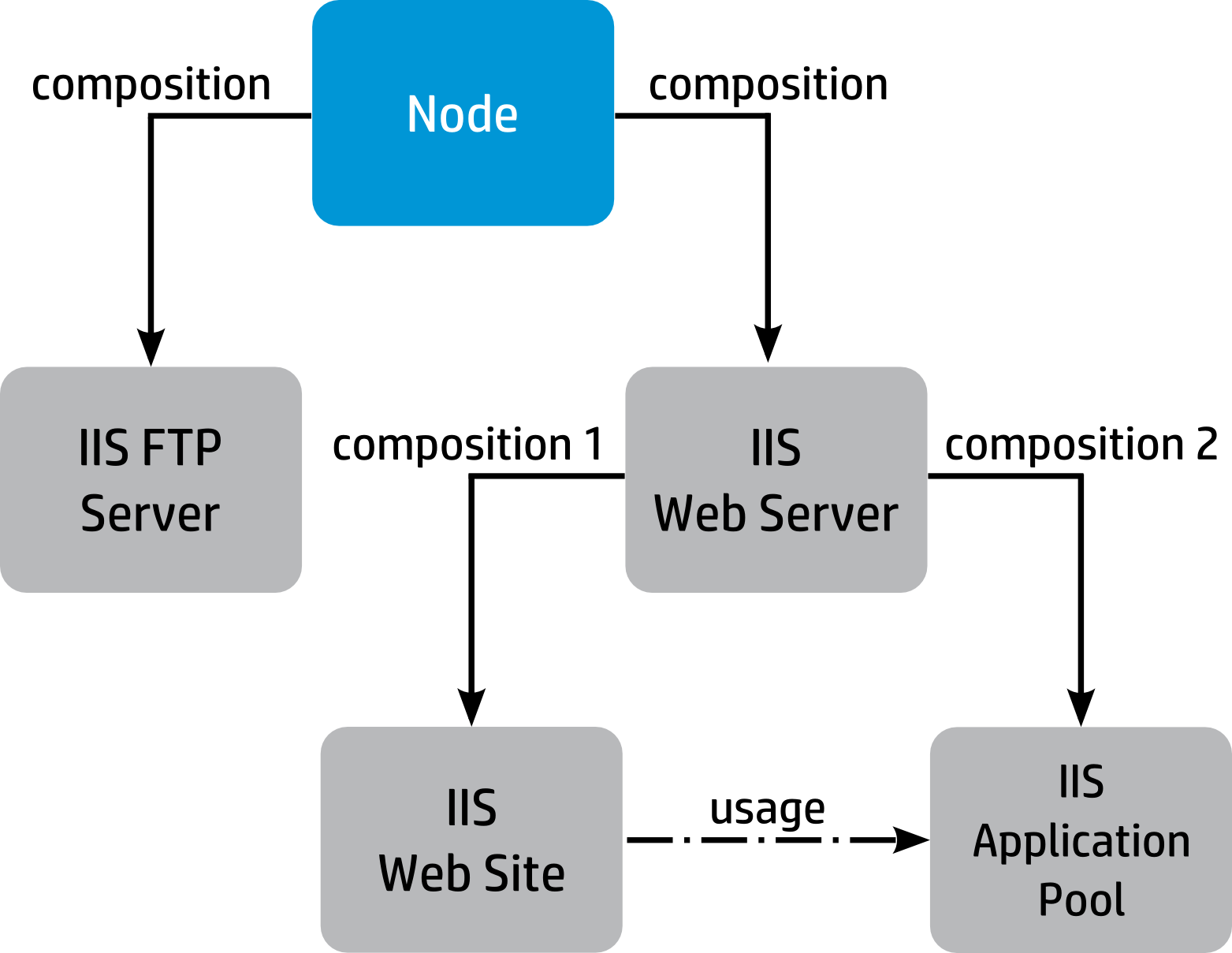
The topology synchronization package maps the following classes of Microsoft SCOM objects from the Internet Information Services management packs to the Run-Time Service Model (RTSM) database of OMi.
FTP Server Service
Microsoft SCOM objects of this class are mapped to CIs of the IIS FTP Server type.
The following table shows the mapping between the Microsoft SCOM object attributes and the CI attributes:
| CI Attribute Name | CI Attribute Value |
|---|---|
Name
|
Microsoft SCOM object attribute: Display Name |
Discovered Product Name
|
Node Name
|
Vendor
|
Microsoft Corp.
|
CIs that represent Microsoft SCOM objects of this class have a parent relation from a Windows CI.
Web Server Service
Microsoft SCOM objects of this class are mapped to CIs of the IIS Web Server type.
The following table shows the mapping between the Microsoft SCOM object attributes and the CI attributes:
| CI Attribute Name | CI Attribute Value |
|---|---|
Name
|
Microsoft SCOM object attribute: Display Name |
Discovered Product Name
|
Node Name
|
Vendor
|
Microsoft Corp.
|
CIs that represent Microsoft SCOM objects of this class have a parent relation from a Windows CI.
IIS Application Pool
Microsoft SCOM objects of this class are mapped to CIs of the IIS Application Pool type.
The following table shows the mapping between the Microsoft SCOM object attributes and the CI attributes:
| CI Attribute Name | CI Attribute Value |
|---|---|
Name
|
Microsoft SCOM object attribute: Display Name |
CIs that represent Microsoft SCOM objects of this class have a parent relation from a Windows CI.
IIS Web Site
Microsoft SCOM objects of this class are mapped to CIs of the IIS Web Site type.
The following table shows the mapping between the Microsoft SCOM object attributes and the CI attributes:
| CI Attribute Name | CI Attribute Value |
|---|---|
Name
|
Microsoft SCOM object attribute: Site Id |
User Label
|
Microsoft SCOM object attribute: Display Name |
CIs that represent Microsoft SCOM objects of this class have a parent relation to a Windows CI.
We welcome your comments!
To open the configured email client on this computer, open an email window.
Otherwise, copy the information below to a web mail client, and send this email to ovdoc-asm@hpe.com.
Help Topic ID:
Product:
Topic Title:
Feedback:





